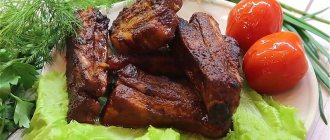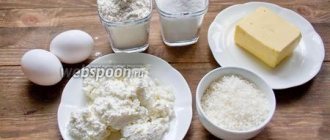I am a Happy Housewife myself and I absolutely love cooking Korean dishes. Firstly, genes have an effect, and secondly, I like the combination of seasonings with familiar ingredients. Thirdly, I like to surprise my family with new culinary delights.
You may find the dishes have a slightly specific taste due to some seasonings and ingredients, but if you understand the whole bouquet of it, you will never be able to refuse them!
For 3 servings I took:
- 150 grams of meat;
- 200 grams of prepared kimchi cabbage;
- 3 cloves of garlic;
- 1 onion;
- Soy sauce;
- Spices (red and black pepper) and herbs.
How to make energizing, spicy Korean kimchi soup?
Make broth from the meat. In the meantime, let's start preparing kimchi.
Rinse and squeeze the kimchi thoroughly; if your kimchi is sour, be sure to soak it in water for a while, and then rinse well so that the cabbage becomes fresh. Our cabbage is fresh, so I lightly washed it to remove the red pepper.
Pour some oil into a preheated frying pan, add onion, kimchi cabbage, garlic, soy sauce, red and black pepper. Fry until the cabbage becomes translucent.
Place the fried cabbage in the broth and boil for another 10 minutes. There is no need to add salt to the soup; thanks to kimchi and soy sauce, it is salty enough.
Serve the soup with chopped pieces of meat, chopped onion feathers, and you can also add slices of tofu.
The spicy Korean kimchi soup reminded us of the broth from the popular Korean ramen noodle soup. It’s not clear whether I prepared it this way, or whether the seasonings in ramen are so close to natural or all natural.
But one thing is clear, we all really liked the soup, moderately spicy and moderately tart. In a word, when you are tired of a festive feast or after drinking alcohol the night before, be sure to remember this Korean soup recipe and prepare it for your family!
And I myself, a happy housewife, will delight you with new delicious and simple recipes!
Kimchi soup came to us from the East. By the way, Japan and Korea have still not agreed on the origin of this dish: each country is sure that the recipe for this dish is its own merit. Let them figure it out themselves, while we prepare this delicious soup.
Preparing cabbage
Kimchi is fermented vegetables. They can be bought ready-made. But they are not always available for sale in the nearest store, and not every housewife wants to travel all over the city in search of them. In addition, the quality of products is sometimes far from expectations.
Usually, Chinese (Beijing) cabbage is used to make kimchi. And you can find it fresh in almost any supermarket. We will ferment it ourselves - the recipe is quite simple. In addition, you can easily adjust the spiciness of the product. When buying already fermented cabbage in the store, you have to make peace with the existing taste. But not everyone respects overly spicy dishes.
We will need:
Let's prepare kimchi:
- Dilute a fairly large amount of salt in cold water (you should get a strong brine).
- Wash the cabbage, cut it in half lengthwise, put it in a bowl or pan and pour in brine so that it completely covers it. Cover the top with a plate, press down with pressure and leave in the refrigerator for two days.
- We will separate the cabbage into separate sheets and rinse them well with running water.
- Let's prepare a hot paste (kankochi) from garlic and the indicated seasonings. The amount of ingredients depends on the desired spiciness. The paste can be made either very spicy or quite soft.
- Brush each cabbage leaf with paste.
- Place in a bowl and place in the refrigerator again for 2 days.
The recipe, as you can see, is not at all complicated. Therefore, if you don’t know where to buy kimchi vegetables, this is not a reason to refuse to prepare a delicious and unusual soup.
Korean-style Chinese cabbage kimchi - a real recipe
The spicy cabbage-based snack that Koreans proudly eat at every meal is made from:
- 2 heads of cabbage;
- 2 redek Daikon;
- 3 bell peppers;
- a bunch of green onions;
- 2 bunches of parsley;
- 100 g ground red pepper;
- 50 g starch;
- 1 kg salt;
- 2 garlic heads;
- 5 liters of cool and 400 ml of hot water;
The method for executing the recipe is as follows:
- The top 2 leaves are removed from each head of cabbage, and then the vegetables are divided in half lengthwise.
- Salt is diluted in 5 liters of water.
- Peking cabbage is filled with brine and placed under pressure for 48 hours.
- After a specified period of time, the cabbage is washed with running water and wrung out.
- The starch is diluted with cool water, then poured with boiling water and left to cool.
- The radish is cut into bars, salted and infused until liquid appears, which is drained.
- Small cubes are prepared from the pepper.
- The greens are chopped and the garlic is crushed.
- At the end, all prepared ingredients, including ground pepper, are mixed.
- The thoroughly mixed appetizer is ready to serve.
Kimchi soup - a simple recipe
There are quite a lot of variations of this dish. In Japan it is often prepared with egg. But since this dish includes wakame seaweed, which is not always easy to get here, we will prepare another type of soup with more affordable products.
We will need:
- 1.5-2 liters of water;
- half a kilogram of pork loin;
- 1-2 tbsp. l. vegetable oil;
- 250 g kimchi cabbage (recipe listed above);
- 2-3 cloves of garlic;
- 10 g paste or chili sauce;
- 1 onion;
- 2 tbsp. l. soy sauce;
- chopped black pepper and green onions to taste;
- tofu for serving (optional)
Cooking time: hour.
Number of servings: 6-8.
Prepare kimchi soup:
- Wash the meat, cut into small cubes or strips, add water and bring to a boil. Remove any foam that appears, put a whole peeled onion in the pan and cook the broth for 20-30 minutes.
- Prepare the cabbage: cut into small strips and sauté in vegetable oil until translucent. Add chopped or crushed garlic in a garlic press, ground pepper, sauces (chili and soy).
- Add the kimchi cabbage to the boiling broth (before this, remove and discard the onion), reduce the heat and cook for 10 minutes.
- Pour the soup into bowls and add a few pieces of tofu and chopped green onions to each bowl.
The recipe is simple, and the result is magnificent. Bon appetit!
Kimchi soup, or kimchichige,
This is the most popular dish in Korea. We can say that this is the “calling card” of Korean cooking. Well, all over the world kimchi is considered a legendary dish. The recipe for spicy kimchi soup is one of the five most famous recipes around the globe. This dish was the favorite of many emperors.
Kimchi soup originated in Korea in the 17th century, when red peppers were introduced into the country. It was he who gave this dish a special spiciness. The classic kimchi recipe includes pickled cabbage, radishes and other vegetables, red hot pepper, and more than twenty types of spices and herbs are added to it. Vegetables and spices undergo a process of fermentation and fermentation, which gives kimchichiga its special taste and aroma.
Kimchi soup has great nutritional value. It is rich in minerals, calcium, phosphorus, iron and a wide variety of vitamins. Korean scientists have long proven that the unique composition of kimchi helps treat diseases such as obesity and stomach cancer. It is also believed that kimchi slows down the aging process of the body. Many ladies will like this dish because it is considered dietary: the calorie content of the soup is only 64 kcal.
Homemade kimchichige is very rich, spicy and satisfying. You can prepare it very quickly, since we will use ready-made kimchi. You will only need to fry fresh vegetables with meat and simmer them a little.
Many people specifically travel to Korea to learn how to cook kimchi soup (kimchichige) the same way the Koreans do. However, do not rush to buy a plane ticket, because our recipe with photos will tell you step by step about all the nuances of preparing this soup at home no worse than Korean chefs.
Slavic version
Most people from the CIS countries find it difficult to cope with the almost unbearable sharpness that the original preparation implies. Because of this, craftsmen modified the composition of kimchi sauce at home, rewriting some of the products as more familiar ones. Additionally, incredible portions of hot pepper were removed.
This variation is great for marinating fish, poultry, and barbecue meat and includes:
- about half a liter of kimchi cabbage juice;
- 2 medium onions;
- 8 cloves of garlic;
- 230 g of ketchup without prominent seasonings and flavors;
- 115 ml rice vinegar;
- ginger root no more than 3 cm;
- 2 tablespoons gochujang;
- 15 ml Worcestershire sauce.
Best materials of the month
- Why you can't go on a diet on your own
- 21 tips on how to avoid buying stale food
- How to keep vegetables and fruits fresh: simple tricks
- How to curb your sweet cravings: 7 unexpected products
- Scientists say youth can be extended
The cooking process can be greatly simplified if you use a blender. Cabbage juice is poured into its bowl with onions, ginger, and garlic, previously peeled and cut into several pieces.
After successful grinding, the mixture is poured into a saucepan, where Worcestershire, vinegar, ketchup, and paste are added. Light the heat over medium and let the mixture cook for about ten minutes. As soon as the contents of the pan become thick, you can turn off the heat.
Cooking steps
People. It is based on pickled vegetables. The most commonly used is Chinese cabbage. For spiciness, the dish is seasoned with pepper. It is worth noting that the recipe for this soup was known back in the 1st century BC. At that time, the dish was called “khancha”. Which literally means “soaked vegetables.” The story doesn't end there. Kimchi is a soup that was included in the list of intangible heritage of humanity under the protection of UNESCO in 2013. However, its belonging specifically to the cuisine of Korea is disputed by the Japanese. In their country, this dish has been prepared for several centuries in many provinces, adding various components to it, from ordinary pumpkin to seafood.
What does it smell and taste like?
The flavor of kimchi is complex and varies depending on the recipe. Key aromatic notes include sour, spicy and umami. The smell will also vary depending on the length of fermentation and the amount of salt or sugar.
Kimchi is a fermented dish, so it has a distinct sour taste. Lactic acid produced by bacteria during the fermentation process also imparts a tangy flavor.
Depending on how much red pepper is used, kimchi sauce can taste either mild or very spicy.
Kimchi (soup) - recipe
This dish has gained popularity all over the world. The recipe according to which it is prepared has undergone some changes in each country. However, in Korea, soup is cooked the old fashioned way, just like in the old days. Its preparation does not pose any particular difficulties. However, some nuances are still worth considering. To prepare a spicy first dish called kimchi you will need:
- 700 grams of pork, preferably loin.
- Chinese cabbage.
- 100 grams of kimchi paste.
- 1 tablespoon
- 50-60 grams
- 1/4 head of onion.
- A few green onions.
- 3 tablespoons chili pepper.
- 250 grams of tofu.
- 3 pinches of black pepper.
- 2 glasses of water.
- Vegetable oil.
For the soup base you will need:
How to quickly cook at home
Original kimchi is prepared in fairly large quantities at once. This is a whole day activity for the whole family. Although this snack should last a long time, in Korea cabbage sells out quite quickly.
Instant spicy Chinese cabbage differs little in composition from the classic method.
For those who are especially impatient, you can reduce the time for pickling vegetables by 4 hours, but you will need to turn the cabbage over during the pickling process.
With daikon
Photo: cabbage kimchi recipe with daikon
Compound:
- 2 fork Chinese cabbage;
- 1 daikon stalk;
- 20 dry chili peppers;
- 1 cup chili powder, a little more than half filled
- 1 onion;
- 3 heads of garlic;
- 2 cm ginger root;
- 1 ½ cups cooked rice;
- 2 ½ tablespoons sugar;
- 11 tablespoon sesame seeds.
Preparation:
- It can be used to make kimchi instead of carrots in the classic recipe, and it is often used as a basis for other types of pickled vegetables. This recipe makes the cabbage very spicy and piquant.
- The cabbage is pickled in brine, as in the original recipe. However, for speed, hot water is used, in which the cabbage must lie for at least 3 hours.
- Also, to speed up the process, it is advisable to cut the cabbage forks into smaller pieces so that the appetizer does not need to be cut again before serving.
- The daikon is cut into slices and dipped into brine to be salted at the same time as the cabbage.
- Pepper pods, garlic, onions, boiled rice, ginger, and daikon are ground in a blender.
- It is better to grind not all of the daikon, but only half. The second is thinly sliced and used with green onions to garnish the dressing.
- The paste obtained in a blender must be diluted with 1 ½ water with sugar and sesame seeds.
- All leaves are smeared with liquid dressing, sprinkled with chili powder on top and mixed in a glass container.
- The dish should remain at room temperature until the end of the day under pressure.
- Then it can be sent to the refrigerator. The longer cabbage is stored, the richer its flavor. The ideal fermentation time is 2 weeks.
Calorie content of Chinese cabbage kimchi with daikon per 100g is 15 kcal.
With bell pepper
Compound:
- 3 kg of Chinese cabbage;
- 1 onion;
- 10 cloves of garlic;
- 1 bell pepper;
- 1 carrot;
- 1 pear;
- 1 bunch of green onions;
- 1 tablespoon sugar;
- 1-2 cups of water left over from cooking unwashed rice;
- 2-3 tablespoons red pepper.
Preparation:
- The step-by-step recipe for Chinese cabbage in Korean is no different from previous versions, since you basically need to pickle the cabbage and prepare the dressing.
- The rice water must be mixed with sugar and pepper.
- The cabbage is soaked in brine for several hours or days, depending on previous experience in preparing snacks.
- The remaining ingredients are ground in a blender, and the resulting paste is mixed with liquid jelly with pepper.
- Cabbage leaves are thickly coated with paste and left for a day at room temperature.
The calorie content of 100 g of this kimchi is about 10 kcal.
Stage one: preparation
Kimchi is a soup that is very simple and quick to prepare. First of all, you should prepare the vegetables. They need to be peeled, washed and chopped into cubes or strips. You also need to cut the tofu. After this, you can begin processing the meat. The loin should be rinsed under warm water and then chopped into thin strips.
Pour a little vegetable oil into a thick-bottomed pan and then add the kimchi paste. The soup is prepared in several stages. The pasta should be simmered for 5 minutes. Then you need to add all the ingredients that are intended to prepare the base of the soup to the pan. All ingredients must be mixed. Then add water, vegetables and meat to the resulting mass.
Cooking process
Kimchi is a soup, the Korean recipe for which is described above, and turns out very tasty if you add tofu to it. But you shouldn’t put this component in right away. The base for the soup with vegetables and meat must be brought to a boil. Cook the dish until the pork is cooked. At the same time, the housewife must ensure that the water does not boil away. When the meat is cooked, turn the heat down and add seasonings, wine and tofu pieces to the pan. That's all. All that remains is to carefully stir the soup. Now you can serve it to the table!
How to cook spicy soup
So, how to make kimchi with eggs? A soup whose recipe anyone can master contains In this case, you can use moer. Mushrooms should be soaked in warm water. They should increase several times in size. The same should be done with algae.
When the moher mushrooms have softened, you need to cut them into portions. In this case, remove the hard cores and stems. Pour 1.5 cups of water into the pan, add mushrooms and bring to a boil. After this, put the chili paste, kimchi paste and soy sauce into the container. must be squeezed and, if necessary, crushed. The tofu also needs to be cut. All ingredients should be added to the soup and cook for a few more minutes.
The egg white must be beaten and carefully added to the dish. The result should be white flakes. The soup is ready. All that remains is to pour it into plates and then sprinkle it with sesame seeds.
Cooking features and interesting facts
According to the Korean kimchi chige recipe, fresh broth is prepared first. Next, kimchi sauerkraut, meat and onions (green and onions) are chopped. Spices and oil (for example, sesame) are added to the chopped ingredients. If kimchi is not spicy enough on its own, you can add red pepper. After which the broth is poured into the remaining ingredients and left on the fire for some time. At the end, tofu is added to the spicy soup and the table is served. In terms of taste, properly prepared kimchi chige should be sour, sweet, spicy and salty at the same time.
You might be interested to know that:
1. Kimchi tige is also known as kimchi stew. This traditional dish can be prepared several times a week in Korean homes. According to the rules of Korean serving, kimchi chige is served boiling. If two or more people are eating, the dish is placed in the center of the table. Most often, spicy kimchi soup is served along with rice and vegetable snacks. 2. For cooking, it is recommended to use kimchi cabbage that has been aged as long as possible, as this will give the soup a deeper rich taste and aroma. Kimchi, which has been fermented longer, also contains a large number of beneficial lactobacilli. 3. Koreans consider kimchi one of the main symbols of the country. According to polls, kimchi ranks second after the country's flag, beating even the Korean alphabet and taekwondo. 4. In American health magazines, kimchi, along with some other dishes, is included in the list of “The Healthiest Food in the World”, as it has a positive effect on the body due to the presence of a number of lactic acid bacteria. 5. Korea's kimchi culture is, according to UNESCO, an intangible cultural heritage of humanity. The Korean government is making efforts to popularize the kimchi brand. In 2001, a standard was also adopted requiring kimchi to be prepared strictly according to a specific recipe.
In conclusion
When preparing kimchi, you should be careful with spices. Spicy food is considered quite normal in Korea. But if you are preparing this soup for the first time, then you should add less hot spices (at least twice). Most often, kimchi is served with rice. Therefore, it is worth boiling several servings of this side dish in advance.
Required ingredients:
- Kimchi (ready) - ¼ kg;
- Pork (preferably loin) - ½ kg;
- Onion - 1 pc.;
- Garlic - 3 cloves;
- Soy sauce - 2 tbsp;
- Hot sauce (preferably chili) - 1 tsp;
- Ground black pepper, green onion, salt - to taste.
Kimchi soup with seaweed and egg
- dried wakame seaweed – 100 g;
- ready-made kimchi paste – 100 g;
- chicken egg - 2 whole or whites from 5 pieces;
- tofu – 100 g;
- water – 0.75 l;
- soy sauce – 50 ml.
- Cut the tofu into pieces and place on plates.
- Soak the seaweed in water and distribute it onto plates.
- Boil three glasses of water, dissolve the paste in it, add soy sauce.
- Beat the eggs with a fork or whisk. Pour the egg mixture into the soup in a thin stream. In a couple of minutes the dish is ready.
All that remains is to pour the kimchi broth with egg into plates that already contain seaweed and tofu, and serve.
Kimchi broth is a popular Asian dish, most often prepared in Korea and Japan. It has a unique aroma and a very pungent taste. This soup is liked by those who are partial to spicy seasonings.
- Kimchi (ready) – ¼ kg;
- Pork (preferably loin) – ½ kg;
- Onion – 1 pc.;
- Garlic – 3 cloves;
- Soy sauce – 2 tbsp;
- Hot sauce (preferably chili) – 1 tsp;
- Ground black pepper, green onion, salt - to taste.
Curious facts
The Korean people consider kimchi their national dish, the main component of which is pickled vegetables (in most cases, Chinese cabbage), richly seasoned with pepper for spiciness. The first mention of a similar dish dates back to the 1st century BC, but at that time this dish was called “khancha”, which means “soaked vegetables”. And in 2013, the dish was included in the UNESCO list of intangible heritage of humanity.
However, the Japanese dispute that kimchi belongs exclusively to Korean cuisine. In different provinces of Japan, kimchi soup has been prepared for many centuries, diluting it with various additives - from pumpkin to seafood.
Today this dish is popular all over the world. There are many magazines, books, and Internet sites that describe the recipe for kimchi soup and also contain photos of the step-by-step preparation of this dish. It does not cause any difficulties in its preparation. You just have to take into account some nuances in how to prepare the soup. It is best to use homemade kimchi, but you should take care of this in advance.
Cooking steps
- To prepare the soup, you need to take Chinese cabbage and cut the head of cabbage in half lengthwise.
- Place the halves in a deep bowl, add heavily salted cold water and leave under pressure for two days.
- During this time, you need to prepare kankochi - a fairly spicy seasoning: mix ground capsicum, red bell pepper, garlic, ground coriander and salt. It is advisable to select the quantity of ingredients according to your taste, depending on what kind of seasoning you want to get - hotly spicy or, conversely, piquantly tender.
- Remove the Chinese cabbage from the brine and rinse thoroughly. Coat each cabbage leaf with the resulting cancocha. Drain the brine from the pan where the cabbage was and place the coated leaves there. Put it under pressure in the cold.
- For kimchi soup, it is best to use broth with portioned pieces of meat.
- You need to add kimchi prepared in a special way to the boiling broth with almost cooked meat. To do this, you need to fry it in a heated frying pan until the cabbage is transparent and add garlic, passed through a press, soy sauce, chili sauce and black pepper.
- Boil the broth with kimchi for about ten minutes until the meat is cooked.
- Kimchi soup is best served with a slice of tofu and chopped green onions on top.
Classic recipe
Depending on the region and the personal preferences of the cook, the recipe can vary significantly. Because of this, it is quite problematic to accurately voice the traditional version of the composition. The difference may also vary depending on what specific base such an unusual additive will be added to.
To make things easier for foreigners who are confused by the variety of offerings, Asian kitchen gurus decided to create a basic version. You can eat it in this simplified version, or continue to conjure up its improvement according to your own skills.
The main ingredients are as follows:
- ginger root about 2.5 cm in size;
- two cloves of garlic;
- half a tablespoon of branded gochujang;
- fresh lime juice – 35 ml;
- fish sauce - 15 ml with the possible addition of a few dry anchovies;
- rice vinegar – 35 ml.
First, ginger is ground together with garlic to form a paste. After this, the resulting result is mixed with gochujang, pouring all the lime juice at once. After this, vinegar and fish sauce are added.
The mixture can be stored without refrigeration, but you should prepare for the fact that in this case its shelf life will be significantly reduced. On average, the base can last about a week without changing its taste in a cool place.
Spicy egg soup
One option for making kimchi soup is a recipe with an egg. The method of its preparation is somewhat different from that described above. For this soup, the role of kimchi is not Chinese cabbage, but dried wakame seaweed, which requires about 100 grams. The ingredients for the soup also include approximately 100 grams of special kimchi paste, which can be purchased in the Asian department of large supermarkets. In addition to the ingredients already listed for the soup, you will also need 5 egg whites, 100 grams of tofu cheese, 50 ml of soy sauce and approximately 700 grams of water.
You need to add kimchi paste, soy sauce to boiling water; you can also add various spices to make the taste sharper and more expressive. Beat the egg whites and carefully pour them into the broth in a thin stream, stirring constantly. Boil everything for a couple of minutes. At this time, place the tofu cheese and wakame seaweed cut into portions on plates. Pour broth over everything. Bon appetit, kimchi soup is ready!
It is worth noting that the calorie content of kimchi soup is low, only about 65 calories, so it can be safely consumed by those who care about their figure. In addition, kimchi has a positive effect on digestion, and Asians consider it a kind of “elixir of youth”, because kimchi contains many vitamins and minerals - beta-carotene, vitamins A, C, E, PP, as well as group B, sodium, potassium , calcium, zinc, selenium, iron, copper, manganese. Therefore, the benefits of this soup cannot be overestimated.
However, despite its positive qualities, you should still refrain from offering kimchi soup to children - it is quite spicy and contains many different spices, which can negatively affect the child’s delicate stomach. But the dish can surprise guests, because its taste is unusual and original, and poured into plates and decorated with tofu cheese and green onions, it looks great.











